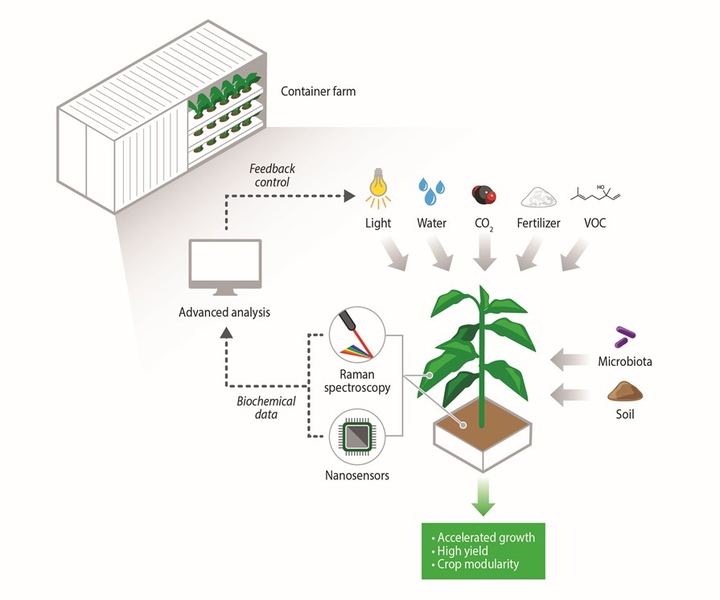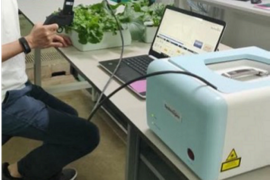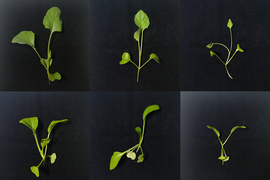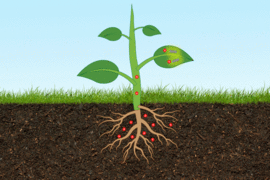According to United Nations estimates, the global population is expected to grow by 2 billion within the next 30 years, giving rise to an expected increase in demand for food and agricultural products. Today, biotic and abiotic environmental stresses such as plant pathogens, sudden fluctuations in temperature, drought, soil salinity, and toxic metal pollution — made worse by climate change — impair crop productivity and lead to significant losses in agriculture yield worldwide.
New work from the Singapore-MIT Alliance for Research and Technology (SMART), MIT’s research enterprise in Singapore, and Temasek Life Sciences Laboratory (TLL) highlights the potential of recently developed analytical tools that can provide tissue-cell or organelle-specific information on living plants in real-time and can be used on any plant species.
In a perspective paper titled “Species-independent analytical tools for next-generation agriculture” published in the journal Nature Plants, researchers from the Disruptive and Sustainable Technologies for Agricultural Precision (DiSTAP) Interdisciplinary Research Group (IRG) within SMART review the development of two next-generation tools, engineered plant nanosensors and portable Raman spectroscopy, to detect biotic and abiotic stress, monitor plant hormonal signalling, and characterize soil, phytobiome, and crop health in a non- or minimally invasive manner. The researchers discuss how the tools bridge the gap between model plants in the laboratory and field application for agriculturally relevant plants. The paper also assesses the future outlook, economic potential, and implementation strategies for the integration of these technologies in future farming practices.
An estimated 11-30 percent yield loss of five major crops of global importance (wheat, rice, maize, potato, and soybean) is caused by crop pathogens and insects, with the highest crop losses observed in regions already suffering from food insecurity. Against this backdrop, research into innovative technologies and tools is required for sustainable agricultural practices to meet the rising demand for food and food security — an issue that has drawn the attention of governments worldwide due to the Covid-19 pandemic.
Plant nanosensors, developed at SMART DiSTAP, are nanoscale sensors — smaller than the width of a hair — that can be inserted into the tissues and cells of plants to understand complex signalling pathways. Portable Raman spectroscopy, also developed at SMART DiSTAP, encompases a laser-based device that measures molecular vibrations induced by laser excitation, providing highly specific Raman spectral signatures that provide a fingerprint of a plant’s health. These tools are able to monitor stress signals in short time-scales, ranging from seconds to minutes, which allows for early detection of stress signals in real-time.
“The use of plant nanosensors and Raman spectroscopy has the potential to advance our understanding of crop health, behavior, and dynamics in agricultural settings,” says Tedrick Thomas Salim Lew SM '18, PhD '20, the paper’s first author. “Plants are highly complex machines within a dynamic ecosystem, and a fundamental study of its internal workings and diverse microbial communities of its ecosystem is important to uncover meaningful information that will be helpful to farmers and enable sustainable farming practices. These next-generation tools can help answer a key challenge in plant biology, which is to bridge the knowledge gap between our understanding of model laboratory-grown plants and agriculturally-relevant crops cultivated in fields or production facilities.”
Early plant stress detection is key to timely intervention and increasing the effectiveness of management decisions for specific types of stress conditions in plants. Tools capable of studying plant health and reporting stress events in real-time will benefit both plant biologists and farmers. Data obtained from these tools can be translated into useful information for farmers to make management decisions in real-time to prevent yield loss and reduced crop quality.
The species-independent tools also offer new plant science study opportunities for researchers. In contrast to conventional genetic engineering techniques that are only applicable to model plants in laboratory settings, the new tools apply to any plant species, which enables the study of agriculturally relevant crops previously understudied. Adopting these tools can enhance researchers’ basic understanding of plant science and potentially bridge the gap between model and non-model plants.
“The SMART DiSTAP interdisciplinary team facilitated the work for this paper and we have both experts in engineering new agriculture technologies and potential end-users of these technologies involved in the evaluation process,” says Professor Michael Strano, the paper’s co-corresponding author, DiSTAP co-lead principal investigator, and the Carbon P. Dubbs Professor of Chemical Engineering at MIT. “It has been the dream of an urban farmer to continually, at all times, engineer optimal growth conditions for plants with precise inputs and tightly controlled variables. These tools open the possibility of real-time feedback control schemes that will accelerate and improve plant growth, yield, nutrition, and culinary properties by providing optimal growth conditions for plants in the future of urban farming.”
“To facilitate widespread adoption of these technologies in agriculture, we have to validate their economic potential and reliability, ensuring that they remain cost-efficient and more effective than existing approaches,” the paper’s co-corresponding author, DiSTAP co-lead principal investigator, and deputy chair of TLL Professor Chua Nam Hai explains. “Plant nanosensors and Raman spectroscopy would allow farmers to adjust fertilizer and water usage, based on internal responses within the plant, to optimize growth, driving cost efficiencies in resource utilization. Optimal harvesting conditions may also translate into higher revenue from increased product quality that customers are willing to pay a premium for.”
Collaboration among engineers, plant biologists, and data scientists, and further testing of new tools under field conditions with critical evaluations of their technical robustness and economic potential will be important in ensuring sustainable implementation of technologies in tomorrow’s agriculture.
DiSTAP Scientific Advisory Board members Professor Kazuki Saito, group director of Metabolomics Research Group at RIKEN Center for Sustainable Resource Science, and Hebrew University of Jerusalem Professor Oded Shoseyov also co-authored the paper.
The research is carried out by SMART and supported by the National Research Foundation (NRF) Singapore under its Campus for Research Excellence And Technological Enterprise (CREATE) program.
DiSTAP is one of the five IRGs of SMART. The DiSTAP program addresses deep problems in food production in Singapore and the world by developing a suite of impactful and novel analytical, genetic, and biosynthetic technologies. The goal is to fundamentally change how plant biosynthetic pathways are discovered, monitored, engineered, and ultimately translated to meet the global demand for food and nutrients. Scientists from MIT, TLL, Nanyang Technological University, and National University of Singapore are collaboratively developing new tools for the continuous measurement of important plant metabolites and hormones for novel discovery, deeper understanding and control of plant biosynthetic pathways in ways not yet possible, especially in the context of green leafy vegetables; leveraging these new techniques to engineer plants with highly desirable properties for global food security, including high-yield density production, drought and pathogen resistance, and biosynthesis of high-value commercial products; developing tools for producing hydrophobic food components in industry-relevant microbes; developing novel microbial and enzymatic technologies to produce volatile organic compounds that can protect and/or promote growth of leafy vegetables; and applying these technologies to improve urban farming.









